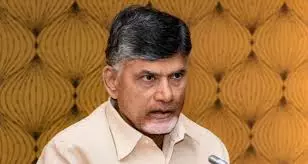Chandrababu To Reach Out To India Inc To Participate In P4 ‘Poverty Alleviation’ Scheme – Deccan Chronicle

Report on Andhra Pradesh’s P4 Programme: A Sustainable Approach to Poverty Alleviation
Introduction to the P4 Programme
On March 30, Andhra Pradesh Chief Minister N Chandrababu Naidu launched the poverty alleviation initiative titled P4 – Margadarsi Bangaru Kutumbam in Amaravati. This programme embodies a Public Private People Partnership (PPPP) model aimed at empowering underprivileged families through active participation from affluent members of society.
Programme Structure and Objectives
The P4 initiative categorizes participants into two groups:
- Margadarsis (Guides): Affluent individuals who commit to upliftment efforts.
- Bangaru Kutumbam (Golden Families): Beneficiary families receiving guidance and support.
The core objective is to eradicate poverty by encouraging the top 10% of affluent citizens to adopt and mentor the bottom 20% of society. This includes providing financial resources, guidance, and empowerment to improve living standards.
Alignment with Sustainable Development Goals (SDGs)
- SDG 1 – No Poverty: The P4 programme directly targets poverty eradication by fostering inclusive partnerships between wealthy individuals and impoverished families.
- SDG 10 – Reduced Inequalities: By bridging the gap between different economic strata, P4 promotes social and economic inclusion.
- SDG 17 – Partnerships for the Goals: The PPPP model exemplifies effective collaboration among government, private sector, and community members to achieve sustainable development.
Engagement and Outreach Strategies
- The Chief Minister has committed to personally contacting CEOs, COOs, CFOs, MDs, and chairpersons of India’s top 100 companies to encourage their participation as Margadarsis.
- During the Federation of Indian Chambers of Commerce and Industry (FICCI) national executive committee meeting in Vijayawada, Naidu proposed the P4 model to industry leaders.
- A dedicated government call centre has been established to monitor programme progress daily.
- Plans include virtual interactions with Telugu communities in India and abroad, inviting Non-Resident Indians (NRIs) to serve as P4 advisors and guides.
Monitoring, Evaluation, and Continuous Improvement
- Regular auditing and quarterly reviews are mandated to assess the programme’s impact.
- Timely feedback will be provided to Margadarsis through detailed reports.
- Surveys will be conducted to evaluate changes in the living standards of Bangaru Kutumbam families before and after adoption.
- Special events involving industrialists, NRIs, celebrities, and elite society members will be organized to promote the P4 concept.
- March 30, the launch date of P4, is proposed to be celebrated annually to showcase achievements.
Current Progress and Government Support
Officials reported that out of 1,915,771 identified Bangaru Kutumbam families across Andhra Pradesh, 87,395 have been adopted by Margadarsis under the P4 model. Union Aviation Minister K Ram Mohan Naidu has adopted 10 poor families and encouraged ministers, bureaucrats, and others to become Margadarsis.
Conclusion
The P4 programme represents a strategic and sustainable approach to poverty alleviation in Andhra Pradesh, aligning closely with multiple Sustainable Development Goals. By fostering partnerships between affluent individuals and underprivileged families, the initiative aims to create lasting social impact and reduce inequalities through collaborative empowerment.
1. Sustainable Development Goals (SDGs) Addressed in the Article
- SDG 1: No Poverty
- The article focuses on poverty alleviation through the P4 programme, aiming to uplift underprivileged families.
- SDG 10: Reduced Inequalities
- The initiative connects affluent individuals with the poorest families to reduce social and economic inequalities.
- SDG 17: Partnerships for the Goals
- The P4 programme is a Public Private People Partnership (PPPP), involving government, private sector, and community collaboration.
2. Specific Targets Under Those SDGs
- Targets under SDG 1 (No Poverty)
- Target 1.2: By 2030, reduce at least by half the proportion of men, women and children living in poverty in all its dimensions.
- Target 1.3: Implement nationally appropriate social protection systems and measures for all.
- Targets under SDG 10 (Reduced Inequalities)
- Target 10.2: Empower and promote the social, economic and political inclusion of all, irrespective of age, sex, disability, race, ethnicity, origin, religion or economic or other status.
- Targets under SDG 17 (Partnerships for the Goals)
- Target 17.17: Encourage and promote effective public, public-private and civil society partnerships.
3. Indicators Mentioned or Implied in the Article
- Indicators for SDG 1
- Number of families adopted under the P4 programme (Bangaru Kutumbam families adopted by Margadarsis).
- Improvement in living standards of adopted families, assessed through surveys before and after adoption.
- Quarterly reviews and timely feedback reports on the impact of the programme.
- Indicators for SDG 10
- Proportion of marginalized families receiving guidance and financial support from affluent individuals.
- Level of social inclusion as measured by participation of diverse groups (including NRIs and elite sections) as guides.
- Indicators for SDG 17
- Number of partnerships formed between government, private sector, and community members.
- Engagement metrics such as number of CEOs, COOs, CFOs, MDs, and chairpersons participating.
- Frequency and effectiveness of events and virtual interactions promoting the P4 programme.
4. Table: SDGs, Targets and Indicators
| SDGs | Targets | Indicators |
|---|---|---|
| SDG 1: No Poverty |
|
|
| SDG 10: Reduced Inequalities |
|
|
| SDG 17: Partnerships for the Goals |
|
|
Source: deccanchronicle.com








